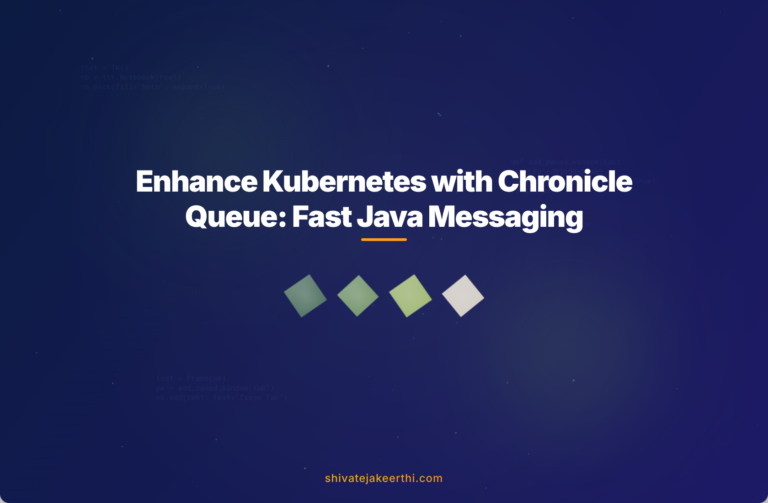When working with microservices in Kubernetes environments, ensuring efficient and reliable communication between containers is key. One increasingly popular solution is Chronicle Queue, a low-overhead, high-performance Java messaging system. Chronicle Queue is perfect for inter-container communication, especially when using Kubernetes’ sidecar pattern and the publish-subscribe model.
To explain why this solution works so well, let’s first clarify what Chronicle Queue does. It’s a Java-based messaging framework focused on fast, persistent, and low-latency inter-process communication—ideal for containerized environments needing high efficiency.
Kubernetes’ sidecar pattern involves attaching helper containers (sidecars) to main application containers to handle duties like logging, monitoring, or inter-container communication. Sidecars keep your main container clean, simple, and focused on its core task.
The publish-subscribe (pub-sub) mechanism involves publishers sending messages via channels without needing to know subscriber identities. Subscribers, meanwhile, can listen to relevant channels, receiving messages they’re interested in—keeping things nicely decoupled and maintainable.
Using Chronicle Queue with Kubernetes Sidecars
When implementing the pub-sub pattern in Kubernetes sidecars, Chronicle Queue offers several advantages:
- High Throughput and Low Latency: Chronicle Queue achieves message transmission in microseconds, ideal for Kubernetes applications where responsiveness matters.
- Persistency: It provides persistent storage, ensuring messages aren’t lost—even if subscriber-side or publisher-side pods temporarily go down.
- Simple Integration: No external messaging infrastructure (like Kafka or RabbitMQ) is required; messages persist locally on disk. It’s especially suitable for sidecar containers, which prefer lightweight, fast solutions.
However, you might face some challenges. Chronicle Queue primarily uses local file storage, so setting it up across multiple Kubernetes pods could require integration strategies, like shared volumes or synchronized file mounts. Proper access control and coordination become important, as these impact reliability and scalability.
Transitioning from Channels to Publish-Subscribe with Chronicle Queue
Historically, Chronicle Queue communicated through distinct “channels”—an approach very similar to how traditional topics are used in messaging frameworks. However, recent Chronicle Queue versions have evolved, encouraging alternative pub-sub-oriented setups.
Rather than relying solely on channels, the latest Chronicle Queue pushes toward unified append-only queues. Publishers continuously append data, while multiple independent subscribers can asynchronously read the queue’s tail. This significantly improves performance and simplifies management by removing complex channel hierarchies.
A Quick Real-world Analogy
Think of Chronicle Queue as a modern digital noticeboard in your organization’s lobby. Departments (publishers) place announcement notices (messages) onto this board without having to know who might read them. Employees from relevant groups (subscribers) scan through the board at their convenience, taking only notes relevant to them and skipping others. This creates a tidy, loosely-coupled communication system.
Practical Example: Chronicle Queue Pub-Sub Setup in Kubernetes
Let’s walk through a simple scenario to visualize how Chronicle Queue can facilitate pub-sub between sidecar containers. Suppose you have separate application containers that generate logs or data streams like metrics or monitoring information. Using a sidecar container equipped with Chronicle Queue, each log or data-enabled pod can swiftly announce its state to interested subscribers elsewhere.
Here’s a step-by-step guide:
- Create Shared Volume: In your Kubernetes Deployment file, declare a shared Persistent Volume Claim (PVC) mounted by both your application container and Chronicle Queue sidecar.
- Publisher Sidecar: Your sidecar’s component will append messages to Chronicle Queue whenever your application generates relevant logs or alerts.
- Subscriber Sidecar: Other Kubernetes pods will mount the same shared volume and—at their own pace—read and consume new messages from the queue.
- Scaling and Reliability: Chronicle Queue allows many concurrent subscribers; additional subscriber pods can independently read and process the queue without blocking or losing messages.
Here’s an example Kubernetes deployment snippet demonstrating this approach:
apiVersion: apps/v1
kind: Deployment
metadata:
name: cq-app-deployment
spec:
replicas: 2
template:
spec:
containers:
- name: main-app
image: your-app-image
volumeMounts:
- name: cq-volume
mountPath: /mnt/queue
- name: cq-sidecar
image: your-chronicle-queue-pub-image
volumeMounts:
- name: cq-volume
mountPath: /mnt/queue
volumes:
- name: cq-volume
persistentVolumeClaim:
claimName: cq-shared-volume
Compared to alternatives like Kafka, RabbitMQ, or REST APIs (see JavaScript-related communication patterns here), Chronicle Queue represents a simpler, lighter, and faster solution for intra-cluster pub-sub needs. Less overhead and better performance are its main selling points.
Best Practices for Chronicle Queue and Pub-Sub in Kubernetes
To get the most from Chronicle Queue with Kubernetes’ sidecar pattern, keep these key practices in mind:
- Tune Queue Settings: Customize queue settings to match your message size, retention policy, and storage needs. Regularly purge old messages to avoid storage overflow.
- Manage Scalability carefully: Chronicle Queue shines locally but isn’t built for distributed scaling. Leverage partitioning or multiple independent queues if scaling is needed.
- Ensure Reliability via Persistent Volumes: Use highly durable Persistent Volume Claims to avoid data loss.
- Implement Observability and Monitoring: Set up monitoring solutions like Prometheus to track message lag, queue size, throughput, and general health. Ensure fast troubleshooting.
Tackling Potential Issues
Potential issues include disk-space exhaustion and performance degradation due to unmonitored growth. Tools like Prometheus and Grafana can help visualize trends and anticipate needs.
Summing Up Chronicle Queue’s Advantages in Kubernetes Sidecars
Using Chronicle Queue for pub-sub messaging in sidecar containers accomplishes several objectives at once: it reduces resource consumption compared to more heavyweight message brokers, simplifies your deployment configurations, and provides extremely fast and consistent message exchange.
Its inherent persistent and non-blocking FIFO queuing makes it particularly suitable for Kubernetes sidecar deployments. As Kubernetes ecosystems evolve further, expecting a rise in lightweight yet performance-focused communication patterns like Chronicle Queue pub-sub configurations seems reasonable.
Given these benefits, Chronicle Queue deserves consideration in your next Kubernetes project. Are there particular Kubernetes use-cases in your environment where Chronicle Queue’s speed and simplicity might help? Let’s discuss!



0 Comments